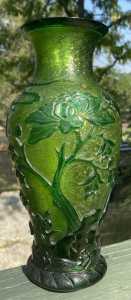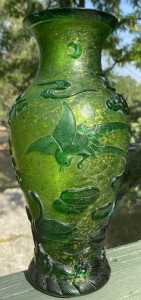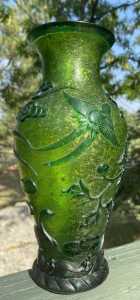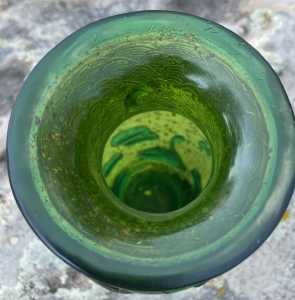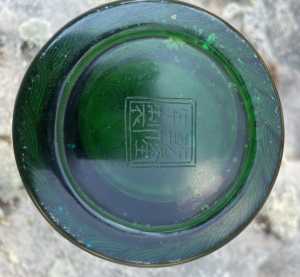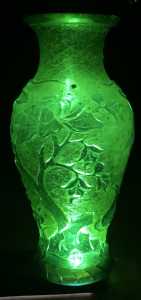The Chinese and Asian Art Forum. For Fans, Collectors and Dealers.
 Basic Rules For the BidAmount Asian Art Forum: Talk about whatever you want. You can even discuss and offer things that are for sale if they are authentic. Maximum image file size per post is 2 MB. Images of 700pxl x 700pxl are optimal if saved at a medium resolution. Be respectful of others and enjoy yourself. Click the YouTube link for a brief tutorial on using the forum. You can also EMBED Videos by cutting and pasting from You-Tube, Vimeo etc.
Basic Rules For the BidAmount Asian Art Forum: Talk about whatever you want. You can even discuss and offer things that are for sale if they are authentic. Maximum image file size per post is 2 MB. Images of 700pxl x 700pxl are optimal if saved at a medium resolution. Be respectful of others and enjoy yourself. Click the YouTube link for a brief tutorial on using the forum. You can also EMBED Videos by cutting and pasting from You-Tube, Vimeo etc.
NOTE: To post an item or add a new post, click open the category title from the FORUM LIST, and CLICK the Blue ADD TOPIC button.
Brian,
Peking glass is a type of case glass, so it's cast in a mould, then carved. Most, but not all, have multiple layers of opaque and brightly colored glass that are carefully carved (ground) to form some very striking designs.
Your vase is unfortunately not one of these fine pieces.
Not sure where to begin on advising you..... What is the beauty in this piece?
Hi Brian,
I don't know anything about Peking glass but I do collect 18th and early 19th century Western glass.
Air bubbles are not a sign of age necessarily; I've seen fakes (or reproductions) of early American glass with lots of bubbles. Contemporary craft glass, as seen in Mexican glass for example, usually have air bubbles.
Scratches on the bottom can be signs of age although fakers will try to imitate them. Look under a magnifying glass for thousands of tiny scratches going in all different directions where the bottom touches the surface.
Glass, like porcelain, can look new if is has been hardly touched, depending on the type of course; a piece that has been untouched and unused for a long time may not have many signs of age.
I hope this helps.
Regards,
Steve
I have found several auction examples that state this as 19th century Peking glass. I have looked under loop there is a lot of wear. It’s all been carved it also has gold flakes in inside the glass. The two glass is also layered.
This example only sold for $100
https://www.liveauctioneers.com/item/80371136_chinese-green-peking-glass-low-relief-brush-pot
I think this is very informative
There is an interesting aspect here worthy of discussion that I appreciate Brian bringing up. Since getting into this stuff over the past couple of years, I have been trying to learn what distinguishes between high and low quality, new and old, etc. In the beginning there were things I thought looked nice that now I would look at as low quality and undesirable. In some cases I have learned to recognize quality where before I could not. But I also have to acknowledge that I have been trained to accept certain things as quality and others as not being quality because that is what is accepted by "the market". I think I am now learning that a healthy amount of retaining my own right to have an opinion about what is or is not desirable is important. If I think something is beautiful, then who is anyone else to tell me it isn't. Now, perhaps it might not be something coveted by the collecting world for whatever reason, but if I am collecting for myself as well as dealing, then it's my business what I like. What does or does not have monetary value in the marketplace is not always synonymous with what is or is not beautiful to me. So if we are buying to resell, then of course we need to care what others will think. But if it is for ourselves, what others think is meaningless.
@johnshoe I have compared this glass vase to may examples it is well rendered this large vase would have taken a great effort to complete. From start to finish would take much longer than a porcelain vase. I have narrowed this vase to mid 19th century. Chinese glass is misunderstood. Yes Tim is right these pieces have not brought the interest to demand high dollars. Because they are not studied the way of porcelain and stone carvings. And as mentioned very hard to date. Never less the vase I purchased is artistry to me at least. Im asked what is the point if it is not to gain in value or if the market rejects it. Well it’s simple I understand the effort. I’m actually happy that some Asian art is not understood or appreciated. I bought this beautiful vase for a few hundred dollars a lot less than a few dinners out with the family.
@lotusblack Brian, I'm sorry for coming off critical in my earlier post.
What strikes a nerve with me, in a general sense, is that collectors of Asian art (at all levels) have a tendancy to justify their decision to buy/collect a piece on the basis of finding individual components that they believe support authenticity (ie. the right foot rim, the right color blue, appropriate wear, etc.). However, these traits are too easy to fake.
What I like about Peter Combs' approach to authentication is that he seems to take at first a very wholistic approach to the appearance of how an object looks, before digging in the weeds to verify the individual traits. For me, this is the most logical approach.
So, when I ask, 'what did you find artistic about your vase', I'm not being facetious (entirely), but rather trying to understand how you came to the conclusion that this vase A) was a good example of the type/style of Peking glass produced in the Qing dynasty, and B) worth stepping out of your spending comfort zone.
Trust me when I say this....NOBODY understands better than I, the impulse to buy an object that they believe could be a valuable treasure! And, while it may seem from the nature of my posts that I pull a rabbit out of a hat every week, let me say that I spend around 20-40 hours every week looking online and at shops for things to buy (it is my occupation), and I've been fortunate to have some high dollar successes to afford me a few mistakes along the way (yes, I make some bad buys!).
However, the reality is that truely collectible art is rare, and I would estimate that 99% of what I see everyday is either inferior quality of work, or poor condition.
What I would hate to see is for an enthusiasts like yourself to get bogged down with a collection of objects that are difficult to resell, don't hold much value and won't appreciate in value, then exhaust your budget to the point that when you are presented with a great opportunity to buy a valuable treasure, you're out of ammo and the next guy gets it. And unfortunately, I see it all the time, at every shop and every antique show....it's very frustrating.
I am not a wealthy person, nobody in my family collected art/antiques, and I had to learn these lessons the hard way (even with the help of some well meaning mentors). Nothing would make me happier than to known that my words, as harsh as they might be sometimes, helps someone like you to successfully find/buy a real treasure and avoid all the difficult pitfalls I've endured along the way.
Restraining the impulse to buy is a hard trait to learn, but it is really necessary unless you are 100000% what you are buying. In otherwords, you should be able to pull up a museum reference or major auction house record, put your piece side by side with it, and anyone with working eyes will say, 'oh yeah, that's it!'.
The response time on this forum is nearly immidiate, versus AsianArt.com which at best you have a 2 day wait. There's no good reason that you can't post a cell photo and wait 30 minutes for someone to give you some additional advice.
Anyway.... Regarding your green peking glass, I think if you go to Christie's or Sotheby's and put 'green peking glass' into the search, you can see some examples for comparison. You can go to LiveAuctioneers.com and do the same thing to see lesser quality examples, too. And of course, most of the major museums offer online searches of their collection.
Hopefully, no hard feelings.... I want to be as helpful to you and everyone as I can.
@greeno107 I respect and appreciate your interest and knowledge. I to was brought up poor I grew up in the projects of Detroit. I guess my buying habits are due to my family never having much. I do want like everyone else to get to that next level and must learn some restraint. Thanks for you help.
@greeno107 I respect and appreciate your interest and knowledge. I to was brought up poor I grew up in the projects of Detroit. I guess my buying habits are due to my family never having much. I do want like everyone else to get to that next level and must learn some restraint. Thanks for you help.
Respect Brian. I agree with both yourself and Greeno. No doubt that glass has value. I wish I knew more about Peking Glass but i have my hands full with porcelain.
Glass is very popular, it will always have value. That is an eye catching glass item so will always have an interested party. I hope it is Peking glass, and even if it is a more modern glass, it was done by a talented glass artist.
I have a few regrets myself about some purchases. I was enthusiastic about getting some academic 18th and 19th Century chinese just to stuff to put into some kind of order.Little collections of say chinese imari, famille rose, kangxi, yongzheng,Qianlong,soft paste qianlong, nanking, late Qing blue and white, and this that and the other but cheap and many.
However, In hindsight, while it was not much more than $200 -$300 and i would now have preferred to have gotten less items but much better quality and condition. My excitment about having tangible items to learn from and put into perspective to home school myself with the faint hope i could restore them and sell them on. Alan a member here, cautioned me on it, but i saw no harm and ploughed ahead, but now as my focus narrows, i don't really need so many of these academic items and they are slowly getting stored away and it is unlikley they wil be restored anytime soon, but some will have to have little restorations that is my conclusion to make sense of getting them in the first place. My idea was to have little collections to learn from. I was consoled also by the fact some people like staples but now im not so sure 🙂 that is a reliable asset.
@short-dong I am not sure of the glass type. There seems to be a lag in this field. First for some reason gold flakes where added during the molding process I am confused by this but is evident it was popular at some point. There are glass studios that are unknown several produces this type. All are listed as Peking glass. So I have to follow what Mark has taught me because glass carving and jade carving were don’t in the same manner. The question is was modern tooling involved also was the glass polished with an abrasive or machined polished. Is the glass carved 3 dimensional or 2. Is the glass molded or hand blown. One method of dating old glass is does it have crizzling. Peking glass is created by forming a base and then adding a layer while it is still being fired and then carving the layer down to the base to create a design. I will post pictures
@lotusblack There is anothber site called Antiquers, I think we have a few members here that are also there. It has a special section on glass and these guys have some members that are very interested in glass.
Do you want a link. Then you can maybe ask about it there also. I am sure you will find answers there as they have a thread on glass.
Thanks for visiting "The BidAmount Asian Art Forum | Chinese Art"
If you sell on eBay, or have a shop feel free to post images and descriptions and links.
Check back often for discussion about the latest news in the Chinese art and antique world. Also find out about the latest Asian art auctions at Sotheby's, Christie's, Bonhams and Tajans.
Auction results for: fine porcelain, ceramics, bronze, jade, textiles and scholar's objects. As well as Japanese, Thai, Vietnamese and other Asian cultures.
Thank you,
Peter Combs
Topics and categories on The BidAmount Asian Art Forum | Chinese Art
Kangxi vases, Kangxi dishes and chargers, Kangxi ritual pieces, Kangxi scholar's objects, Qianlong famille rose, Qianlong enamels, Qianlong period paintings, Qianlong Emporer's court, Fine porcelain of the Yongzheng period. Chinese imperial art, Ming porcelain including Jiajing, Wanli, Xuande, Chenghua as well as Ming jades and bronzes.
The BidAmount Asian Art Forum | Chinese Art
A free Asian art discussion board and Asian art message board for dealers and collectors of art and antiques from China, Japan, Korea, Thailand, Cambodia, Vietnam and the rest of Asia. Linked to all of the BidAmount Asian art reference areas, with videos from plcombs Asian Art and Bidamount on YouTube. Sign up also for the weekly BidAmount newsletter and catalogs of active eBay listing of Chinese porcelain, bronze, jades, robes, and paintings.
The art of calligraphy - and for the ancient Chinese it certainly was an art - aimed to demonstrate superior control and skill using brush and ink. Calligraphy established itself as one of the major Chinese art forms during the Han dynasty (206 BCE - 220 CE), and for two millennia after, all educated men were expected to be proficient at it.
The Museum’s collections of Asian art span nearly five millennia and encompass the cultures of China, the Himalayas, India, Japan, Korea, and Southeast Asia. In 2007, the Museum launched an initiative to create dedicated galleries for the collection, beginning with a gallery for the arts of Korea ...
Chinese art is full of symbolism, in that artists typically seek to depict some aspect of a totality of which they are intuitively aware.
China Online Museum is the finest online museum of Chinese art. It features Chinese calligraphy, painting, ceramics, bronzes, carving, and other artworks.
Chinese Ceramics & Works of Art. Overview Upcoming auctions Contacts Auction results ... Christie’s sales of Chinese ceramics and works of art showcase centuries of Chinese history. Held throughout the year in London, New York, Paris and Hong Kong, they attract a wide audience of collectors and connoisseurs vying for pieces as diverse as ...
Explore Asian Art Week. Contact the Specialist Department. Chinese Paintings ... Senior Specialist, Head of Sale. [email protected]. Tel:+1 212 641 5760. Bid in-person or online for the upcoming auction:Fine Chinese Paintings on 10 September 2019 at New York. Bid in-person or online for the upcoming auction:Fine Chinese Paintings on 10 ...
Discover an abundance of must-see art from all corners of a vast continent at Christie’s NY Asian Art Week. From contemporary classical and Chinese paintings to works with exemplary provenance from the Art Institute of Chicago, our Rockefeller Paza galleries will be full of ancient treasures and contemporary masterworks in a salute to the vibrant arts of Asia.
Sold to benefit The Art Institute of Chicago’s Asian Art Acquisition Fund, the sale features 84 lots with a focus on Ming and Qing porcelains, and offers a rare insight into the taste for collecting Chinese ceramics and works of art in the Midwest from the end of the 19th century through the 1980s. Highlights include two Wanli wucai garlic-head vases, a Qianlong mark and period, blue and ...
Specialist, Chinese Paintings, Christie's London Dr Malcolm McNeill is a Specialist in Chinese Paintings at Christie’s, based in London. He previously worked as an assistant curator of the Chinese collections and the Victoria and Albert Museum in London, as a researcher at the British Museum, and as a translator and tour guide at the National Palace Museum in Taipei.
The Christie's Education 2020 Conference: The Chinese Art Market 18 Jun 2019 Christie’s Education is delighted to announce our first international academic conference in Asia which will take place in Hong Kong from 26-27 November 2020 at the Hong Kong Convention and Exhibition Centre and will run in parallel with Christie’s Hong Kong Autumn Auctions.
The summer Chinese Art sale in Hong Kong will feature works of art from several private collections, including Qing porcelains and textile from the collection of the legendary Chinese art dealer A. W. Bahr (1877–1959), fine gilt bronze Buddhist sculptures from an old Hong Kong collection, an East Asian collection of Qing dynasty wine cups and jades, and a Japanese collection of Song ceramics ...
Sotheby's Chinese Works of Art Department holds two auctions each year in London, New York, Hong Kong and Paris.
Chinese Art - View Auction details, bid, buy and collect the various artworks at Sothebys Art Auction House.
With more than 340 Chinese works of art dating from the Neolithic to the Republic periods, highlights of this sale include a selection of Qing Imperial monochromes from the collection of Arnold and Blema Steinberg, early ceramics from the Art Institute of Chicago and Chinese porcelain and works of art from the collection of Henry Arnhold.
Results: Sotheby's Asia Week achieved $52.4 million in six strong auctions, exceeding pre-sale estimates. With 76.5% of lots sold and 60.3% of lots surpassing high estimates, the Asian art sales at Sotheby's indicate continued collector interest in the finest works of art from China, India and and the Himalayas.
Today's sale of Important Chinese Art will proceed as planned with sessions at 10 AM and 2 PM EDT. Sotheby's will be monitoring the weather conditions throughout the day and will be available to coordinate alternative bidding options should conditions make it difficult for clients to attend the auction in person.
Bonhams Chinese Art department is renowned for offering the finest works of art representing the richness and breadth of China's artistic heritage, particularly Imperial porcelain, white and spinach green jades, cloisonné and Buddhist art. Specialised international auctions are held globally, including London, Hong Kong and San Francisco.
Bonhams : Chinese Works of Art We use cookies to remember choices you make on functionality and personal features to enhance your experience to our site. By continuing to use our site you consent to the use of cookies. Please refer to our privacy and cookie policies for more information.
Bonhams Fine Art Auctioneers & Valuers: auctioneers of art, pictures, collectables and motor cars. We use cookies to remember choices you make on functionality and personal features to enhance your experience to our site. By continuing to use our site you consent to the use of cookies. ... Chinese Art (US) General enquiries
Bonhams : Fine Chinese Art We use cookies to remember choices you make on functionality and personal features to enhance your experience to our site. By continuing to use our site you consent to the use of cookies. Please refer to our privacy and cookie policies for more information.
Bonhams Fine Art Auctioneers & Valuers: auctioneers of art, pictures, collectables and motor cars Bonhams : Asian Art We use cookies to remember choices you make on functionality and personal features to enhance your experience to our site.
Bonhams are international auctioneers of fine Chinese and Japanese art. We specialise in rare Imperial and Export Chinese ceramics and works of art, as well as Japanese ceramics, fine and decorative works of art from the Neolithic Period to the 20th century. View on map
Bonhams Fine Art Auctioneers & Valuers: auctioneers of art, pictures, collectables and motor cars. We use cookies to remember choices you make on functionality and personal features to enhance your experience to our site. By continuing to use our site you consent to the use of cookies. ... Asian Art Bonhams. Work. 22 Queen St.
